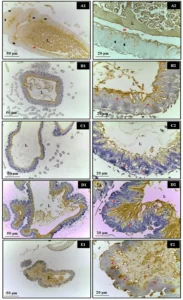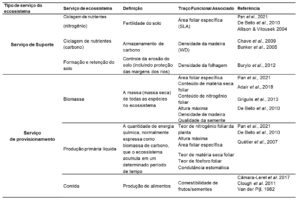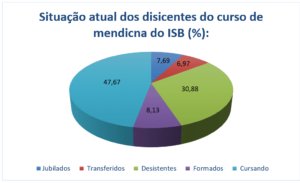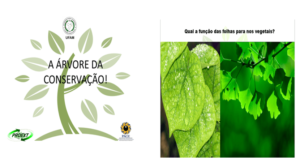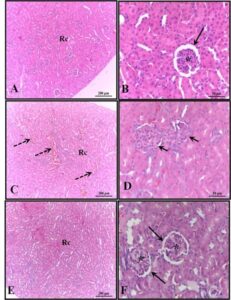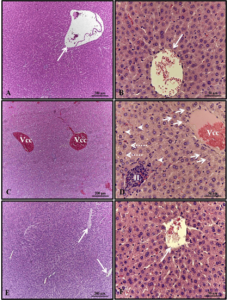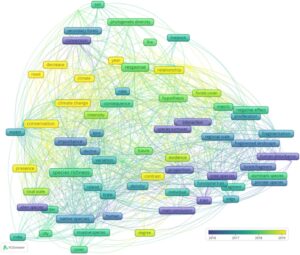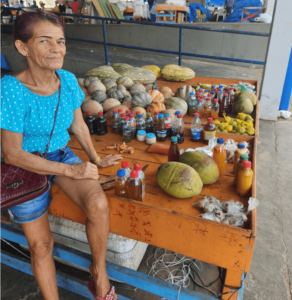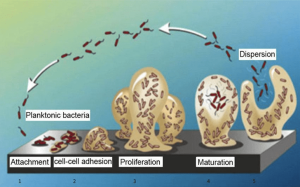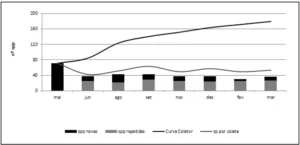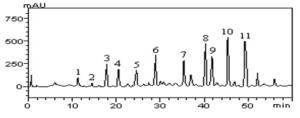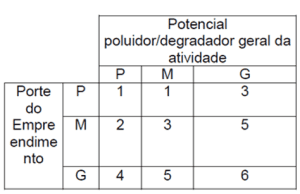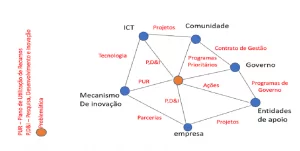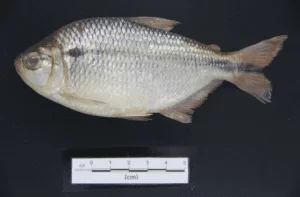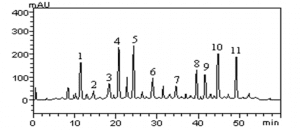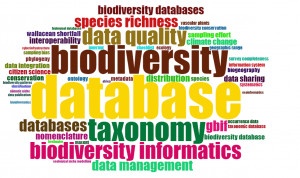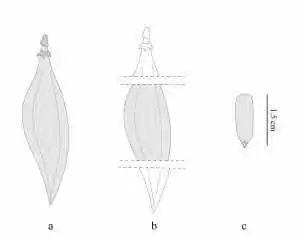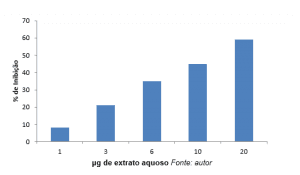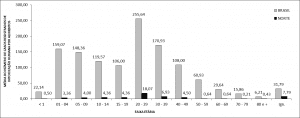ORIGINAL ARTICLE
LEITE, Ana Erundina de Luna Moraes [1], ALVES, Elizabeth Simões do Amaral [2], MELO, Felipe Pereira de [3], BARROSO, Inaê Cristina Guerreiro Pinto [4], SOARES, Anísio Francisco [5], IMAZAKI, Pedro Henrique Didimo [6], MEDEIROS, Elizabeth Sampaio de [7]
LEITE, Ana Erundina de Luna Moraes. et al. Overview of the milk production chain in Brazil: development and perspectives. Year 08, Ed. 03, Vol. 01, p. 170-185. March 2023. ISSN:2448-0959, Access link: https://www.nucleodoconhecimento.com.br/biology/milk-production, DOI: 10.32749/nucleodoconhecimento.com.br/biology/milk-production
ABSTRACT
Dairy farming is an activity of enormous prominence not only in Brazil but throughout the planet, exerting enormous influence on the economy, generating jobs not only in the rural area but throughout the production chain, offering milk and derivatives that are among the main foods in the food chain as it is rich in protein and vitamins. However, despite Brazil being one of the largest producers in the world, Brazilian milk still needs to be more present internationally. This low presence abroad is due, among other reasons, to the high cost of production and its low quality. On this basis, this research aims to survey the panorama of the milk production chain in Brazil. The research method is based on a literature review with a descriptive and exploratory nature. As a result, the research shows the importance that dairy activity has acquired in the country. Moreover, public policies that value the sector encourage the production of dairy products with quality and safety and create the conditions to make that the developed technologies reach the producers.
Keywords: Agriculture, Dairy Cattle, Dairy Products, Animal Production, Profitability.
INTRODUCTION
The milk production chain is one of the main economic activities in Brazil, contributing enormously to generating jobs and income. With distribution in almost all Brazilian municipalities, milk production involves more than one million producers in the countryside and generates millions of jobs in other segments of the chain. In the second quarter of 2022, the gross value of primary milk production reached around 25,095 tons, placing Brazil among the ten largest milk producers in the world (CONAB, 2022). In the food industry, this value more than doubles, with net revenue from dairy products reaching BRL 70.9 billion, second only to the sectors of meat derivatives and processed coffee, tea and cereals (ABIA, 2020).
These expressive numbers demonstrate the importance of a sector undergoing a remarkable transformation over the last two decades. During this period, milk production increased by almost 80% using practically the same number of cows, thanks to the increase in herd productivity. Many other changes have occurred in the production structure, including a significant reduction in the number of producers and the intensification of production systems. Adopting new technologies is a limiting and stimulating factor in the significant increase in the productivity of animals, land and labour and, consequently, the scale of farm production (EMBRAPA, 2020). In this way, Brazil became the third largest milk producer in the world, but still with great potential to be explored, mainly in terms of productivity gains, to also become one of the leading players in the global market for milk and derivatives (FAO, 2019).
This potential can be justified because dairy farming is present in about 5,497 of Brazilian municipalities, and in 53, dairy farming is the main economic activity. Minas Gerais is the Brazilian state that leads the production of milk with 8,939,159 litres (26.4%), in second place is Paraná with 4,375,422 (12.5%), in third place is Rio Grande do Sul with 4,242,293 litres (12.5%), in fourth place is Goiás with 3,084,080 (9.1%) and in fifth place is Santa Catarina with 2,970,654 litres (8.8%) (IBGE, 2019). Rondônia, in turn, is in seventh place nationally and 1st in the North Region (SEAGRI, 2020).
Therefore, it is essential to clarify that milk is one of the main branches of activity in the Brazilian economy (ABIA, 2020). In addition, Brazil is traditionally known as one of the largest milk producers in the world, which began as an extractive activity, which led to it becoming representative of the primary agricultural commodities with extreme importance for the economy (IBGE, 2010).
Although in Brazil there are bodies that certify milk production, there is no obligation to inform the systematized production so that, in real time, it is possible to obtain numbers and carry out projections for the increase or maintenance of milk production in order to maintain the quality and marketed prices.
Given the above, this research aimed to consolidate, through a review of narrative and qualitative literature, to establish an overview of the milk production chain in Brazil, covering its developments and the perspectives of the sector.
METHODOLOGY
This article is a literature review, narrative, qualitative, whose method provides knowledge through the incorporation of the applicability of the results of significant studies for practice, determining the current state of knowledge regarding the chosen theme. The literary search used for research and selection of articles was obtained from the following databases: Google Scholar, Electronic Library Online (Scielo), Legislation Consultation System (Sislegis), International Literature in Health Sciences (Medline), SciVerse Scopus, Web of Science, National Library of Medicine National Institutes of Health (PubMed), which took place between November 2022 and January 2023.
The following inclusion criteria were adopted: articles indexed on the described platforms and website of the Ministério da Saúde (MS) and the Ministério da Agricultura Pecuária e Abastecimento (MAPA), articles written in Portuguese, English and Spanish; articles available in full; articles that fit the proposed theme, free articles, works whose reading of abstracts and titles corresponded to the objectives of this research.
Among the exclusion criteria used in the research, we have: publications that were not found in the aforementioned databases; studies whose results did not apply to the objectives of this study; articles whose readings of titles and abstracts were not related to the theme of the present study; scientific works in languages other than Portuguese, English and Spanish; paid articles, articles whose methodology was not described in an understandable way.
With the search strategy, 50 files were found, including complete articles and legislation. For this review, 25 articles and 13 legislations were pre-selected based on the title and abstract analysis. Then, the files that complied with the inclusion criteria of this review were evaluated in full.
BIBLIOGRAPHICAL ANALYSIS
MILK PRODUCTION
The Brazilian economy and its performance, in general, are linked to the behaviour of the agricultural sector, regardless of the historical period evaluated. This same sector is also responsible, in a certain way, for the process of territorial occupation of the country: whether from the cultivation of sugar cane on the coast (16th century), the breeding of cattle and the cultivation of cotton (19th century) in the Northeast, the coffee cycle, especially in the Southeast region (19th and early 20th centuries), passing through the massive production of grains considered as commodities, such as soy and corn, which occupied the Midwest region (20th century) and which expanded to the North region, accompanied by cattle breeding in the 21st century (CASTRO, 2023).
In 40 years, Brazilian milk production had a significant increase, consequently making the country one of the main producers in the world (EMBRAPA, 2019). From 1974 to 2014, national production almost quadrupled, going from 7.1 billion to more than 35.1 billion litres of milk. However, from 2015 onwards, production fell for two consecutive years, a fact hitherto unheard of since the beginning of the historical series (IBGE, 2019). It occurs in all Federation Units, where there are subsistence properties, using rudimentary techniques with a daily production of fewer than ten litres, and others making use of advanced technologies comparable to the most competitive in the world with a daily production of more than 60,000 litres (EMBRAPA, 2019). Thus, with the return of growth in 2017, the panorama of annual averages of actual milk prices varied between 1.46 in 2017 and 2.26 BRL/litre in 2021.
In summary, throughout the last decade (2010-2019), milk production increased by 469 million litres (16.3%), there was a decrease of 151,000 cows milked (17.3%) and a significant increase in herd productivity dairy in the order of 1,225 litres/head (30.8%) (ZOCCAL et al., 2019).
It is essential to point out that, at the global level, 2020 and 2021 saw relatively low supply growth, motivated by the uncertainties arising from the COVID-19 global pandemic. However, negatively pressured by the increase in grain prices during this period, the beginning of 2022 saw more growth in gross prices paid to producers, closing January at the equivalent of 0.55 USD/kg of milk (GASQUES et al., 2022).
A series of supply, demand and other price factors, such as wholesale and retail dairy products or inputs, influence the producer price of milk. In addition, according to Grigol (2020), attention should be paid to the fact that the market prices of milk products in the market and milk negotiations in a given month strongly influence the prices to be paid to the producer in the following month. For this reason, analysing the relationship between the price of milk paid to the producer and the prices of its main derivatives to discover which influences the former the most is an essential step in anticipating trends and better understanding the behaviour of prices.
Finally, according to data from FAO (2018), more than 80% of the milk produced in developing countries comes from small producers, identifying that dairy farming is a significant generator of income and employment under the family farming model. The agro-industrial milk complex in all Brazilian regions is an essential generator of income, employment and taxes. Nogueira Netto et al. (2003) highlighted that dairy farming is developed in approximately 40% of rural properties in Brazil, being exploited predominantly by small and medium producers.
MILK EXPORT
Agribusiness data in Brazil are surprising. The sector’s surplus exceeded the trade balance, which recorded 50.9 billion USD in net revenue, while agribusiness exceeded 100 billion USD (CEPEA, 2021). Serigati (2013) states that agricultural activity for export has been an important driver for the growth of the Brazilian domestic product. Agribusiness is now responsible for 52.2% of Brazil’s total exports, and this result is linked to the high productivity motivated by technological increments used in the field (SISCOMEX, 2020). It can be seen that the country’s agribusiness has been the driving force behind the economy, even in the difficult times experienced during the COVID-19 pandemic. The sector now has a share of 26.1% of the gross domestic product in 2020, according to the CEPEA study.
The changes imposed on dairy farming in Brazil, especially in the early 1990s, after the market’s opening, created a new profile for the sector. A long-term development policy, combined with unfair and predatory competition from international subsidies granted to the main dairy commodities by the countries of the European Union and the United States, interfered sharply with the competitiveness of the Brazilian dairy sector. Nevertheless, milk production grew at an average rate of 4.5% per year in the last decade, going from 15.6 billion litres in 1993 to 22.6 billion in 2003, placing Brazil as the sixth largest producer of milk, with a volume corresponding to approximately 4.5% of world production (FERREIRA et al., 2022).
Although world dairy production has reached the figure of 500 billion litres per year, the part transacted internationally is at most 6% or approximately 30 billion litres. Of this amount, half is traded freely, without government assistance. The other part is traded by the European Union (EU) and the United States, which produce and export with high subsidies, reducing international prices. This situation inhibits the continuity of productive development in countries that do not use these trade-distorting practices (MACEDO, 2021).
Despite the distortions in the market, the international market represents a severe problem. In countries with a subsidy, milk receives resources of 45 billion USD annually, followed by beef and rice, with approximately 25 billion USD annually. Only the amount spent on domestic support measures for milk production in OECD countries represents one and a half times the value sold annually worldwide. If export subsidies are considered, this figure is even more surprising, even exceeding the price per ton on the international market. Taking dairy products as an example, the European Union subsidizes its butter exports by 1,850.00 USD a ton, 930.00 USD a ton of powdered milk, and more than 1,000.00 USD a ton of cheddar cheese. This block is responsible for 64% of subsidized exports, while the United States covers another 26% (COSTA et al., 2022).
Based on this scenario, foreign trade is dynamic and has been changing daily. In this regard, Brazil and China are considered emerging countries and have many similarities. However, many differences and contrasts result in reciprocity and possibilities for the intensification of their trade relations (OLIVEIRA et al., 2022).
EVOLUTION OF DAIRY PRODUCTION
The first historical report on dairy production in Brazil dates back to 1641, with an image of cow milking on a farm near Recife (DIAS, 2012). However, in 1888, with the abolition of slavery, livestock breeding expanded from one end of Brazil to the other in the vicinity of large consumer centres. Nonetheless, until the 1950s, the activity moved slowly, without major technological developments (VILELA et al., 2017).
Over the years, in a global context, the milk production chain has undergone accelerated technological modernisation within the production process. Among the factors correlated with global trends, the following stand out: reduction in dairy cow herds; increase in the individual size of farms area, number of cows and production volume; reduction in the number of dairy farms; improvement of the herd’s genetic potential; increase in production in most producing countries; and growth in world supply and production quality (EMBRAPA, 2011; VILELA et al., 2017).
Within the national context, it is clear that the size of farms is still small compared to other countries. However, Brazilian farms are growing in terms of individual production volume. Therefore, its insertion in the international market is linked to the adaptation to technological and market changes, especially in productive efficiency and production quality. So, the technological trajectory of agriculture in recent years has gone through the intense adoption of technologies to increase productivity and reduce environmental damage (SOUZA; LIMA, 2003; PEROBELLI et al., 2007; ALMEIDA; PEROVELLI; FERREIRA, 2008; CAMPOS; PEREIRA; TEIXEIRA, 2014).
Faced with changes in the national and international production context, one can see an expansion in the milk supply and an increase in quality related to per capita income growth and changes in consumer habits. The importance of this sector has aroused the interest of several studies that have focused on identifying the spatial pattern of production, which consists of monitoring production in a previously defined period of time, and efficiency in the production chain. (LOPES; REIS; YAMAGUCHI, 2007; HUNT et al., 2009; SIQUEIRA; KILMER; CAMPOS, 2010).
CONSUMPTION OF MILK AND DERIVATIVES
Milk and its derivatives are part of the list of essential foods for the well-being of millions of Brazilians. According to the Brazilian Agricultural Research Corporation – EMBRAPA (2020), milk is economically important for the income and survival of the world’s population and is a fundamental source of nutrients for human development. In order to meet the daily needs of calcium, it is necessary to consume 1000 mg or three servings of dairy products daily, ideally by ingesting 200 mL of milk, 50 g of cheese and 90 g of yoghurt (BRASIL, 2014).
Milk products are known as dairy products that can be fermented and unfermented. According to Normative Instruction nº 46, of October 23, 2007 of the Ministério da Agricultura Pecuária Abastecimento (MAPA), fermented milk is understood to be the products resulting from the fermentation of pasteurised or sterilised milk using lactic ferments. Some examples of products derived from milk are cheese, butter, cream, condensed milk, cottage cheese, cream cheese, ricotta, ice cream, margarine, cream and fermented milk such as yoghurt, kefir and curd. In addition, there are non-fermented dairy beverages, a product not added to cultures of microorganisms or fermented dairy products subjected to adequate heat treatment (BRASIL, 2007).
Despite giving rise to other more solid foods, such as cheese and butter, raw milk is also responsible for creating other variations of itself that are widely consumed. In this way, it can generate buttermilk: a by-product of butter manufacture and can be used both in liquid form (in drinks) and dry form (ingredient); whey: a by-product of cheese making and has been used in the preparation of sports drinks, ricotta and other items; skimmed milk: a by-product of the manufacture of cream and has been used in the manufacture of various dairy or powdered products; and casein, which are the main proteins of cow’s milk and represent 80% of its protein content: it has been used as a main ingredient in the bakery and confectionery sectors. Therefore, even variations of the raw form of milk can be used within the dairy industry (GARCIA, 2017).
INNOVATIONS AND PERSPECTIVES
Due to technological advances, the dairy market seeks innovations to increase productivity and competitiveness, reducing costs and ensuring product quality. However, national dairy farming has challenges such as production costs, increasing consumer demand regarding the safety and quality of dairy products, concern about the environmental impact, and the guarantee of animal welfare. In this context, investing in advanced technologies in managing the milk production chain in Brazil is essential to achieve this market objective (PEREIRA, 2018).
For example, in the carousel system, cows enter one of the 60 compartments (the number can vary). Each stall has a scale to weigh the animal and a sensor that records the amount of milk expressed. To begin with, as soon as the carousel rotates to the second stall position, the animal receives a jet of water to wash the udder and then an antiseptic spray to sanitise it before placing the teat cups. Then, the teat cups are removed, and the pubescent receives a new antiseptic spray; in the last position of the carousel, a few drops of water are sprinkled on the head so that it leaves the carousel in reverse. Finally, for the exit, a gate allows the cow to be released into the pasture with the others or to separate it from the herd in case of any anomaly. Furthermore, it is important to mention that during the whole process, the cows are fed in the trough, which helps to reduce the animals’ stress. The carousel system is computerised, records the entire process, generates reports with the quantity and characteristics of the milk, and notifies the farmer by cell phone when there is a problem, for example (BRINGHENTI, 2022).
According to this perspective of acquisition for establishing the technological dairy production chain, it is evident that automation is a necessary reality to increase productivity, reduce operating costs and guarantee quality and standardisation in the milk production chain. However, the application of the carousel system is a reality only for large dairy producers in Brazil, considering that it is a system that requires high investments and specialised advice, making it costly. Nevertheless, it is worth making an effort, given that the benefits for the breeder, such as agility, efficiency, competitiveness and quality, are undeniable (FERREIRA, 1991).
LEGISLATION OVER TIME
Over the years, with the increasing consumption and, consequently, the production and commercialisation of milk and derivatives, there was a need to establish quality standards for these products to protect consumers against fraud and waterborne and foodborne diseases. Thus, considering the need to regulate the sanitary control of milk and milk products, Decree nº 24549, the first Federal Inspection regulation specific to milk and milk products, was approved on July 3rd 1934 (BRASIL, 1934).
Then, another legislation appeared in 1952, Decree nº 30691 of March 29th, which came to unite the existing regulation in a single document, the Regulation of Industrial and Sanitary Inspection of Products of Animal Origin (RIISPOA), compiling several articles, including Art. 510 that identifies the types of milk, Art. 517 which conceptualises pasteurisation and Arts. 537 and 541 setting the standards for pasteurised milk. The RIISPOA brought standards for dairy derivatives and all other non-dairy products of animal origin (BRASIL, 1952).
Due to the need to update the norms governing the inspection of milk and derivatives, Ordinance nº 146, of March 7th 1996, was published, which, considering the need to standardise the methods for preparing Products of Animal Origin (POA), approved the Technical Regulations of Identity and Quality (RTIQs) of dairy products, such as cheese, butter, cream, powdered milk, among others (BRASIL, 1996).
Many changes in the consumption and production of milk and derivatives have taken place over the years, and the sanitary legislation was then outdated and with an inefficient inspection system, there was a need for modernisation. Thus, in 1999, Ordinance nº 56 was submitted to public consultation with the proposal of the National Program for the Improvement of Milk Quality (PNMQL), establishing minimum standards of milk quality (BRASIL, 1999).
In 2002, considering the need to improve and modernise federal health legislation on milk production, Normative Instruction (IN) nº and type C, also dealt with pasteurised milk and refrigerated raw milk, making it mandatory to analyse antibiotic residues and defining the standards for Somatic Cell Count (CCS) and Standard Plate Count (CPP), in addition to approving the Technical Regulation for the collection of refrigerated raw milk and its transport in bulk (BRASIL, 2002).
Later, IN nº 51 was updated, changing some of its annexes and paragraphs, with the publication of IN nº 62 of December 29th 2011, which approved the RTIQs of type A milk, refrigerated raw milk, pasteurised milk and refrigerated raw milk and its transport in bulk. This NI eliminated type B milk (BRASIL, 2011).
Then, as the standards required by legislation were being achieved and the dairy chain evolved, a new update by RIISPOA came with Decree nº 9013 of March 29th 2017, amended by Decree nº August 2020. The new RIISPOA is more concise and objective, with 410 articles less than the one published in 1952, brought about changes in the nomenclatures of establishments, with more modern concepts, including the HACCP System (Hazard Analysis and Critical Control Points System) (BRASIL, 2017; BRASIL, 2020).
In this update process, INs nº 76 and nº 77 of November 26th 2018, were also published, which were later amended by INs nº 58 and nº 59 of November 6th, 2019, respectively. Such Normative Instructions approved new Technical Regulations to establish the identity and quality characteristics that refrigerated raw milk, pasteurised milk and type A pasteurised milk must present, with some new quality parameters, in addition to establishing criteria and procedures for the production, packaging, conservation, transport, selection and reception of raw milk in establishments registered with the official inspection service, being more emphatic about the co-responsibility of the industrial sector with the quality of the product from its raw material, having this to describe a new Self-Control Plan for the dairy industry with the Milk Supplier Qualification Plan (PQFL) to be developed with the company’s milk producer (BRASIL, 2018a; BRASIL, 2018b; BRASIL, 2019a; BRASIL, 2019b).
Concerning the microbiological quality standards of dairy products currently in force, in addition to the Technical Regulations of Identity and Quality of each dairy product issued by the Ministry of Agriculture, Livestock and Food Supply (MAPA), considered as complementary standards in 2022, such standards were updated with the publication of IN nº 161, of July 1st, by the Ministry of Health – MS / National Health Surveillance Agency – ANVISA. This IN establishes microbiological standards for dairy products and foods in general (BRASIL, 2022).
As we have seen, the legislation related to the inspection of milk and derivatives has been updated more constantly in recent years, which demonstrates the concern on the part of the responsible entities to improve the quality of the products that are being generated and consumed in our country, increasing our standards in order to match the quality standards of more developed countries, thinking not only about consumer health but also about trade relations abroad.
FINAL CONSIDERATIONS
Brazil has great potential to be an exporter of milk and dairy products, taking great advantage of its land and water availability and tropical climate. In addition, the country has a successful history in the dairy sector, which guarantees a large management capacity of the production chains. However, it is essential to emphasise that technology in the productive sector is a primordial factor in meeting the regulations of the current legislation, which establishes the improvement of raw materials and their by-products.
To guarantee the sector’s development in the coming decades, overcoming adverse scenarios, prolonged drought or torrential rain in short periods and actions by the many players in the chain will be necessary. For this, it is essential to assess the challenges and trends, as well as the strategies to be adopted to raise the income of the productive sector, understanding that one of the imperatives of increasing income is the increase in productivity.
REFERENCES
ABIA. Sector Numbers – Turnover. Brazilian Association of Food Industries, 2020. Available at: https://www.abia.org.br/vsn/anexos/faturamento2019.pdf. Access in: 13 mar. 2023.
ALMEIDA, E. S.; PEROBELLI, F. S.; FERREIRA, P. G. C. There is spatial convergence of agricultural productivity in Brazil. Journal of Rural Economics and Sociology, v. 46, n. 1, p.3 1-52, 2008.
BRASIL. Ministry of Agriculture, Livestock and Supply. Decree No. 24,549, of July 3, 1934. Approves the Federal Inspection Regulation for Milk and Dairy Products. Federal Official Gazette: section 1, Brasília, DF, p. 13913. 1934.
BRASIL. Ministry of Agriculture, Livestock and Supply. Decree No. 30,691, of March 29, 1952. Approves the new Regulation for the Industrial and Sanitary Inspection of Products of Animal Origin. Official Gazette of the Federative Republic of Brazil: section 1, Brasília, DF, n. 155, p. 10.785. 1952.
BRASIL. Ministry of Agriculture, Livestock and Supply. Ordinance No. 146, of March 7, 1996. Approves the Technical Regulations for Identity and Quality of Dairy Products. Official Diary of the Union: Brasília, DF. 1996.
BRASIL. Ministry of Agriculture and Supply. Ordinance No. 56, of December 7, 1999. Submits to Public Consultation the Technical Regulations for Production, Identity and Quality of type A milk; type B milk, type C milk, cooled raw milk, pasteurized milk, goat’s milk and Collection of cooled raw milk and its transport in bulk. Official Gazette of the Federative Republic of Brazil: section 1, Brasília, DF, n. 234, p. 34. 1999.
BRASIL. Ministry of Agriculture, Livestock and Supply. Normative Instruction No. 51, of September 18, 2002. Technical regulations for the production, identity and quality of type A milk, type B milk, type C milk, pasteurized milk and refrigerated raw milk and the technical regulation for the collection of refrigerated raw milk and its transport in bulk. Federal Official Gazette: section 1, Brasília, DF, n. 183, p. 13, 20. 2002.
BRASIL. Ministry of Agriculture, Livestock and Supply. Normative Instruction No. 46, of October 23, 2007. Adopt the Technical Regulation of Identity and Quality of Fermented Milk. Federal Official Gazette: section 1, Brasília, DF. 2007.
BRASIL. Ministry of Agriculture, Livestock and Supply. Normative Instruction No. 62, of December 29, 2011. Approves the Technical Regulation of Production, Identity and Quality of Type A Milk, the Technical Regulation of Identity and Quality of Refrigerated Raw Milk, the Technical Regulation of Identity and Quality of Pasteurized Milk and the Technical Regulation for the Collection of Refrigerated Raw Milk and its Transport in Bulk. Federal Official Gazette: section 1, Brasília, DF, n. 251, p. 6. 2011.
BRASIL. Ministry of Health. Food guide for the Brazilian population. 2a ed. Brasília: Ministry of Health, 2014. Available at: http://bvsms.saude.gov.br/bvs/publicacoes/guia_alimentar_populacao_brasileira_2ed.pdf. Access in: 13 mar. 2023.
BRASIL. Ministry of Agriculture, Livestock and Supply. Decree No. 9,013, of March 29, 2017. Regulates Law No. 1,283, of December 18, 1950, and Law No. 7,889, of November 23, 1989, which provide for the industrial and sanitary inspection of products of animal origin. Federal Official Gazette: section 1, Brasília, DF, p. 3. 2017.
BRASIL. Ministry of Agriculture, Livestock and Supply. Decree No. 10,468, of August 18, 2020. Amends Decree No. 9,013, of March 29, 2017, which regulates Law No. 1,283, of December 18, 1950, and Law No. 7,889, of November 23, 1989, which provide for the industrial and sanitary inspection of products of animal origin. Federal Official Gazette: section 1, Brasília, DF, p. 6. 2020.
BRASIL. Ministry of Agriculture, Livestock and Supply. Normative Instruction No. 76, of November 26, 2018. Technical Regulations that establish the identity and quality characteristics that refrigerated raw milk, pasteurized milk and type A pasteurized milk must have. Official Gazette of the Union: section 1, Brasília, DF, n. 230, p. 9. 2018a.
BRASIL. Ministry of Agriculture, Livestock and Supply. Normative Instruction No. 77, of November 26, 2018. Establishes the criteria and procedures for the production, packaging, conservation, transport, selection and reception of raw milk in establishments registered with the official inspection service. Federal Official Gazette: section 1, Brasília, DF, n. 230, p. 10. 2018b.
BRASIL. Ministry of Agriculture, Livestock and Supply. Normative Instruction No. 58, of November 6, 2019. Amends Normative Instruction No. 76, of November 26, 2018. Federal Official Gazette: section 1, Brasília, DF, n. 216, p. 18. 2019a.
BRASIL. Ministry of Agriculture, Livestock and Supply. Normative Instruction No. 59, of November 6, 2019. Amends Normative Instruction No. 77, of November 26, 2018. Federal Official Gazette: section 1, Brasília, DF, n. 216, p. 18. 2019b.
BRASIL. Ministry of Health. Normative Instruction No. 161, of July 1, 2022. Establishes microbiological standards for food. Federal Official Gazette: section 1, Brasília, DF, p. 235. 2022.
BRINGHENTI, A. Dairy farm model project with free stall system. Annals of the Science, Technology, Art and Culture Fair of the Instituto Federal Catarinense do Campus Concórdia, v. 5, n. 1, p. 82-82. 2022.
CAMPOS, S. A. C.; PEREIRA, M. W. G.; TEIXEIRA, E. C. Trajectory of modernization of agriculture in Minas Gerais from 1996 to 2006. Applied Economics, v. 1 8, n. 4, p. 717-739, 2014.
CASTRO, L. S. Spatial Aspects of Brazilian Milk Productivity in the Census Years of the 21st Century. Portuguese Journal of Regional Studies, v. 1, n. 61, p. 105–120, 2023. Available at: http://review-rper.com/index.php/rper/article/view/534. Access in: 09 jan. 2023.
CENTRO DE ESTUDOS AVANÇADOS EM ECONOMIA APLICADA – CEPEA. PIB Brazilian Agribusiness. Cepea. Esalq. Usp.Br, 2021, Available at: https://www.cepea.esalq.usp.br/br/pib-do-agronegocio-brasileiro.aspx. Access in: 13 mar. 2023.
COMPANHIA NACIONAL DE ABASTECIMENTO – CONAB. Monthly Analysis of Milk and Derivatives – October 2022. Companhia Nacional De Abastecimento, 2022. Available at: https://www.conab.gov.br/info-agro/analises-do-mercado-agropecuario-e-extrativista/analises-domercado/historico-mensal-de-leite. Access in: 13 mar. 2023.
COSTA, K. P.; LEVY, P. M.; NEGRI, F. Nonnenberg, M. B. International economic growth and the competitiveness of agribusiness. Rio de Janeiro: IPEA, 2022. Available at: https://www.ipea.gov.br/portal/images/stories/PDFs/TDs/td_1333.pdf. Access in: 13 mar. 2023.
DIAS, J. C. Brazil’s dairy roots. 11ª ed. São Paulo: Barleus, 2012. 167 p.
EMPRESA BRASILEIRA DE PESQUISA AGROPECUÁRIA – EMBRAPA. Technical Circular. Milk production chain in Brazil: primary production. Embrapa Gado de Leite, 2020. Available at: https://ainfo.cnptia.embrapa.br/digital/bitstream/item/215880/1/CT-123.pdf. Access in: 13 mar. 2023.
EMPRESA BRASILEIRA DE PESQUISA AGROPECUÁRIA – EMBRAPA. Milk Production in Southeast Brazil. Milk production systems for different regions of Brazil. Embrapa Gado de Leite – Sistema de Produção, n. 4. Brasília, 2011.
EMPRESA BRASILEIRA DE PESQUISA AGROPECUÁRIA – EMBRAPA. Milk Yearbook 2019. Empresa Brasileira De Pesquisa, 2019. Available at: <ainfo.cnptia.embrapa.br/digital/bitstream/item/198698/1/Anuario-LEITE 2019.pdf. Access in: 13 mar. 2023.
FOOD AND AGRICULTURE ORGANIZATION OF THE UNITED NATIONS – FAO. FAO STAT – Livestock Primary. Roma, Italy, 2019. Available at: https://www.fao.org/faostat/en/#data/QCL. Access in: 13 mar. 2023.
FOOD AND AGRICULTURE ORGANIZATION OF THE UNITED NATIONS – FAO. Dairy Production and Products – Milk Production (2018). Available at: http://www.fao.org/dairy-production-products/socio-economics/smallholders-inthe-value-chain/es/. Access in: 13 mar. 2023.
FERREIRA, I. C. et al. The Contribution and Relevance of Agribusiness to Brazil. Magazine CEDS, São Luís, v. 2, n. 10, 2022.
FERREIRA, A. M. Manejo reprodutivo e eficiência da atividade leiteira. Juiz de Fora, MG: EMBRAPA, n. 46, p. 15. 1991.
GARCIA, F. A. et al. Carvalho, VS, Soares, NR, Ferreira, SM. Quality parameters of raw milk supplied to the dairy processing industry. In: Colloquium Agrariae. p. 372-380. 2017.
GASQUES, J. G. et al. Agricultural productivity: results for Brazil and selected states. Agricultural Policy Magazine, n. 3, p. 87-98, 2022.
GRIGOL, N. Coronavirus raises uncertainties and may pressure prices in May. Milk Bulletin, v. 26, p. 1-4, 2020.
HUNT, D. et al. Comparison of performance indicators of dairy farmers located inside and outside agrarian reform settlements in Triângulo Mineiro. Journal of Rural Economics and Sociology, v. 47, n. 1, p. 211-248, 2009.
INSTITUTO BRASILEIRO DE GEOGRAFIA E ESTATÍSTICA – IBGE. Household budget survey 2008 – 2009. Household food purchase per capita: Brazil and Major regions. Rio de Janeiro: IBGE; 2010. Available at: http://sban.cloudpainel.com.br/source/SBAN_Importancia-do-consumo-de-leite.pdf. Access in: 13 mar. 2023.
INSTITUTO BRASILEIRO DE GEOGRAFIA E ESTATÍSTICA – IBGE. Agricultural Census. Definitive Results. Brasilia/Rio de Janeiro: Ministry of Economy, 2019.
LOPES, P. F.; REIS, R. P.; YAMAGUCHI, L. C. T. Costs and scale of production in dairy farming: a study in the main producing states of Brazil. Journal of Rural Economics and Sociology, v. 45, n. 3, p. 567-590, 2007.
MACEDO, M. Important economic activity for Brazil. Brasília, 2021. Disponível em: https://www.educamaisbrasil.com.br/enem/historia/ciclo-do-ouro. Access in: 13 mar. 2023.
NOGUEIRA-NETTO, V.; MARTINS, M. C.; NERI, C. B. S. Promised land. Agroanalysis, v. 22, n. 10, p. 46-51, 2003.
OLIVEIRA, B. L. C. M.; OLIVEIRA, M.A.; SILVA, P. W. M. Trade relationship between Brazil and China: a study on agriculture. Acertte, v. 2, n. 4, 2022.
PEREIRA, F.; MALAGOLLI, G. A. Technological innovations in milk production. SIMTEC – Fatec Taquaritinga Technology Symposium, v. 4, n. 1, p. 11, 2018.
PEROBELLI, F. S. et al. Productivity of the Brazilian agricultural sector (1991-2003): a spatial analysis. New Economy, v. 17, n. 1, p. 65-91, 2007.
SEAGRI. Government of Rondônia and the Ministry of Agriculture seek solutions to promote milk production in Rondônia. 2020. Available at: http://www.rondonia.ro.gov.br/governo-de-rondonia-e-ministerio-da-agricultura-buscam-solucoes-para-fomentar-a-producao-do-leite-em-rondonia/. Access in: 13 mar. 2023.
SERIGATI, F. C. Agriculture pulls the PIB. Agroanalysis, v. 33, n. 02, p. 13-14, 2013.
SIQUEIRA, K. B.; KILMER, R. L.; CAMPOS, A. C. The dynamics of farm milk price formation in Brazil. Journal of Rural Economics and Sociology, v. 48, n. 1, p. 41-61, 2010.
SISTEMA DE COMERCIO EXTERIOR – SISCOMEX. Agribusiness accounted for more than half of Brazilian exports in July, Brasília, 2020. Available in: http://siscomex.gov.br/agronegocio-representou-mais-da-metade-das-exportacoes-brasileiras-em-julho/. Access in: 13 mar. 2023.
SOUZA, P. M.; LIMA, J. E. Intensity and dynamics of agricultural modernization in Brazil and in the states of the Federation. Brazilian Journal of Economics, v. 57, n. 4, p. 795-824, 2003.
VILELA, D. et al. The evolution of milk in Brazil in five decades. Agricultural Policy Magazine, v. 26, n. 1, p. 5-24, 2017.
WAQUIL, P. D. Export: sectoral transformations and trade relations with Brazil. Economic Theory and Evidence, v. 24, n. 50, p. 6-25, 2021. Available in: http://seer.upf.br/index.php/rtee/article/view/7843/114114380. Access in: 15 dez. 2022.
ZOCCAL, R. et al. Dairy farming in Brazil: quantification and characterization of producers. In: Congress Of The Brazilian Society Of Rural Economy, Administration And Sociology, 53., 2015, João Pessoa. Agriculture, environment and development: annals. João Pessoa: Sober, 2019.
[1] Doctoral student of the Graduate Program in Animal Bioscience. ORCID: 0000-0002-4169-8439. LATTES CURRICULUM: http://lattes.cnpq.br/0013339049357627.
[2] Doctoral student of the Graduate Program in Animal Bioscience. ORCID: 0000-0001-5078-4104. LATTES CURRICULUM: http://lattes.cnpq.br/2775935070259137.
[3] Doctoral student of the Graduate Program in Animal Bioscience. ORCID: 0000-0002-0478-0345. LATTES CURRICULUM: http://lattes.cnpq.br/6230060058139214.
[4] Graduating in Veterinary Medicine. ORCID: 0000-0002-3148-0217. CURRICULUM LATTES: http://lattes.cnpq.br/2867014322557334.
[5] PhD in Biochemistry and Physiology, Master in Physiology, Biologist. ORCID: 0000-0003-1493-7964. LATTES CURRICULUM: http://lattes.cnpq.br/9044747136928972.
Sent: 28 of February, 2023.
Approved: 08 of March, 2023.

